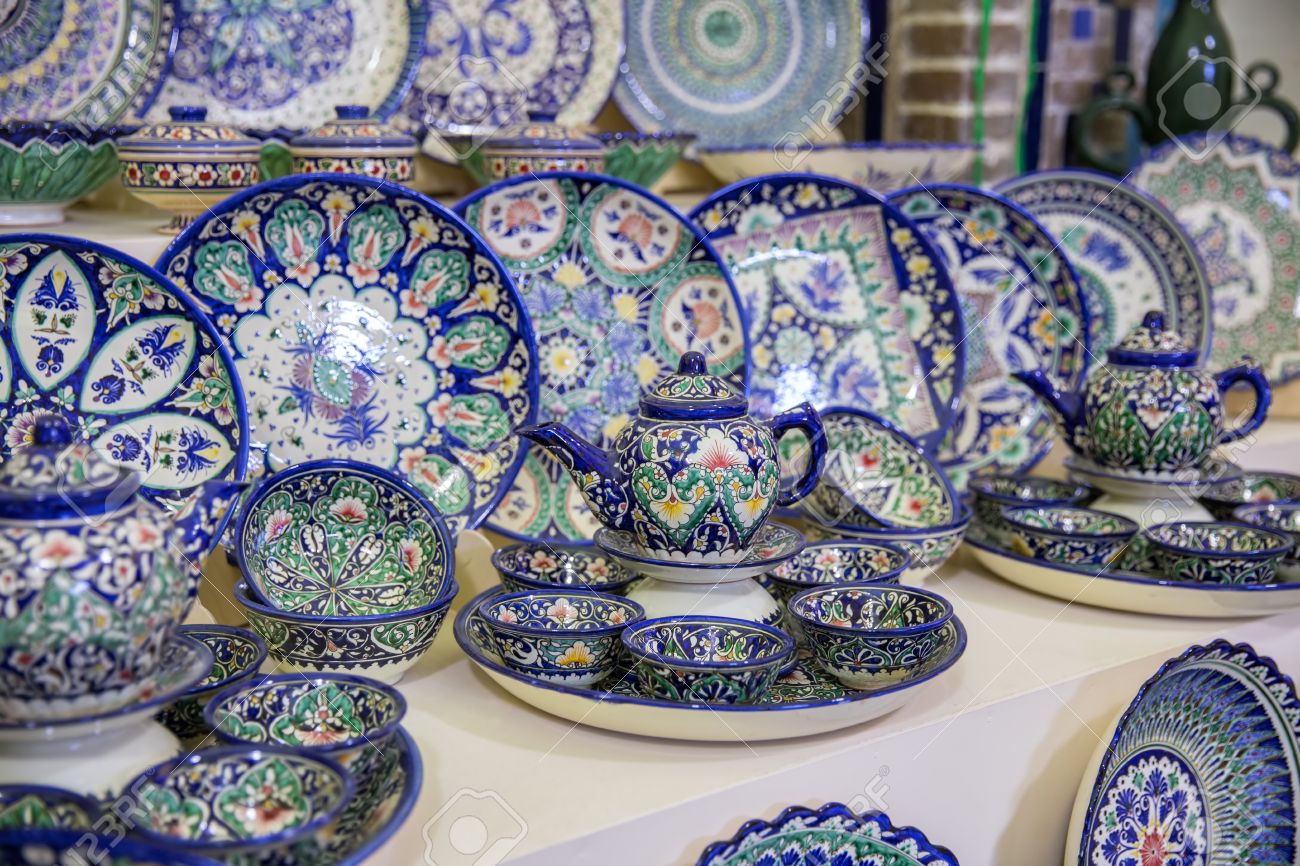Applied Arts. Uzbek applied arts display an abundance of style, materials, and ornamentation. Silk, ceramics and cotton weaving, ganch and wood carving, metal engraving, calligraphy, and miniature painting are some of the techniques passed down through the generations. In the past, each region had its own cultural and ethnic traditions, the unique features of which were established by local guilds that strengthened these characteristics through their art.
Сeramics. Ceramics is one of the most ancient and appreciated crafts the Uzbek people have ever possessed. Uzbek art pottery with a rare expressiveness revealed the true nature of people’s creative genius. Rishtan and Gijduvan ceramics, glassware from Bukhara, as well as the numerous clay figurines, toys and dishes are decorated with distinctive ornaments and many unique patterns, which represent the warmth of the soul of the Uzbek people, their nature, and unique culture.

Sale of traditional Uzbek dishes in a souvenir shop at the Samarkand market
Wood carving. Since ancient times, wood has been highly valued and respected by the local craftsmen who have demonstrated genuine mastery of wood carving. The facades of many buildings in Uzbekistan have been for centuries decorated with wooden fretted columns, panels and doors.
At all times, the cities and villages of Khorezm and Ferghana Valley were renowned for their skillful wood carvers. Masters from Bukhara and Gijduvan had the reputation of “universal carvers.” Carvings made in Tashkent, Samarkand, Shakhrisabz, and Vabkent were also in great demand. The main styles of Uzbek wood carving had developed by the late 18th-early 19th centuries.
Ganch Carving. One of the most refined types of applied art in Uzbekistan is carving on ganch. Ganch carving is one of the oldest types of artistic crafts in Uzbekistan, representing a unique school in its style and specificity of techniques. Ganch is popular in Central Asia, binding material that is achieved from burning special rock containing gypsum and clay. In the past, it was used for plastering walls and used as solution for bonding bricks. For many centuries, ganch carving reached the height of true art.
GOLD Embroidery. Among the most common and popular Uzbek crafts since the 7th century has been embroidery. Every city and town in Uzbekistan has its own unique features in ornamentation, composition, color range, and stitching.
The finest kind of embroidery—gold embroidery—is still practiced in Bukhara. In the 19th and early 20th centuries, the famous Bukhara caftans embroidered with golden and silver threads, smart horsecloths, joynamaz (prayer rugs) and other embroidered items were exported to many countries.
Suzani embroidery. For centuries, Uzbek homes have been decorated with thin silk embroidered suzani. The word “suzani” comes from the Persian word for needle. Suzani can take many forms ranging from large, decorative wall hangings and curtains to small functional household items, such as bags to hold tea or spices.
Suzani from all regions of Uzbekistan share several common features. They were typically made on handmade fabrics called mato. The background fabric was hand-woven on a loom, which produced narrow strips of fabric that were of a convenient size for embroidery.

MinIature painting. Miniature painting is an essential part of artistic expression in Uzbekistan, where the miniatures are admired for their rich creative imagination and perfect execution. The art of the miniature painting is well known and spread throughout Uzbekistan, introduced to the area at the time of the Persian conquest. Not only are miniatures historic documents, depicting court scenes or episodes of local lore, but they are also the expression of their time.
Ikat fabric. Uzbekistan has long been noted for its wealth of unique and decorative applied arts. Its position along the ancient Silk Road led to the development of silk and cotton production in the region centuries ago, resulting in a long and rich history of intricate embroidery and colorful textiles. Uzbekistan is particularly noted for its Atlas and Adras fabrics, known as Ikat.
Fine arts. The most ancient monuments of art in the territory of Uzbekistan are the rock paintings of animals and hunting scenes of the Paleolithic period in the Zarautsoi settlement. Some rock drawings of animals in Khojakent and Bustanlik belong to the Neolithic period.


